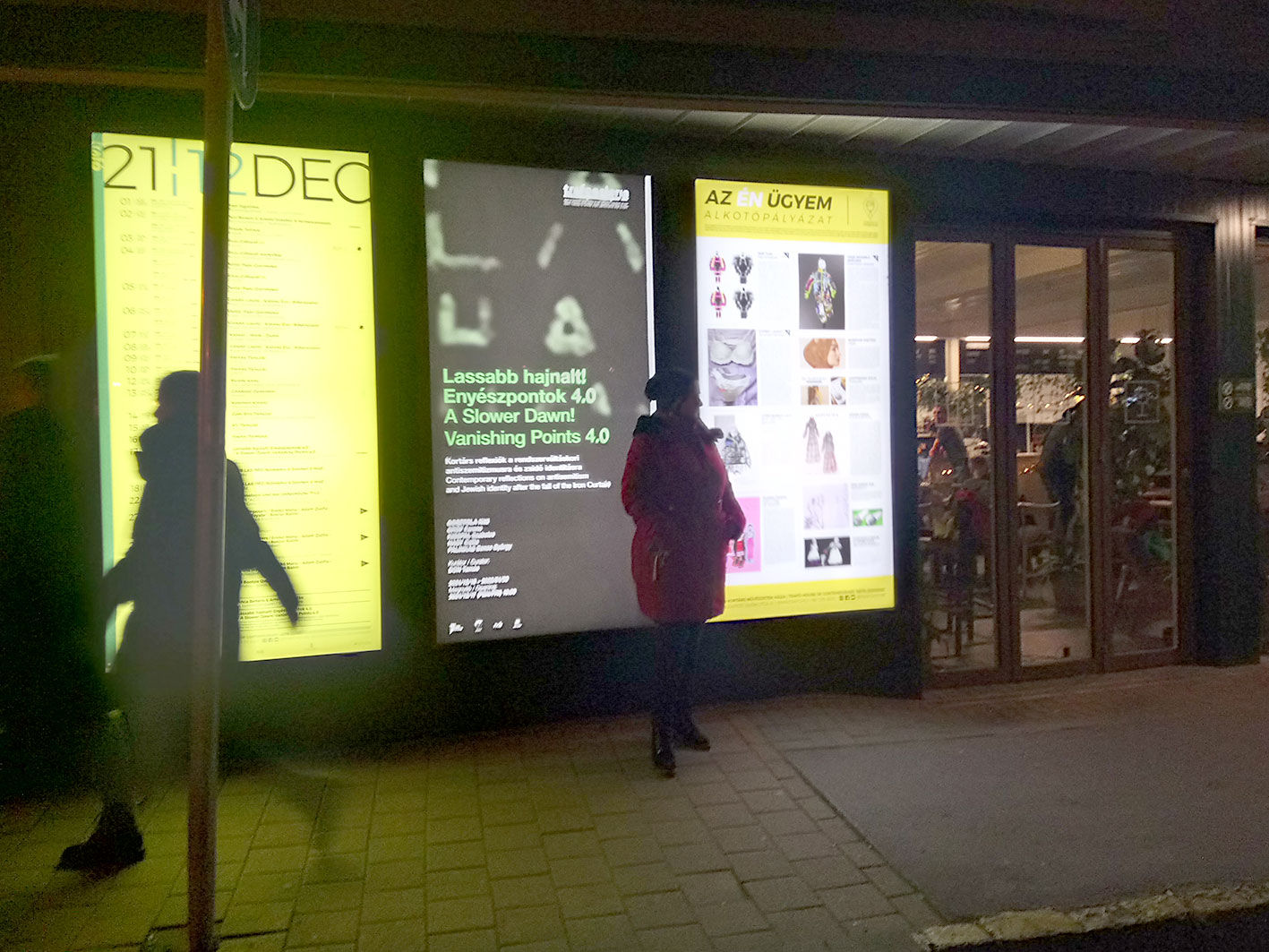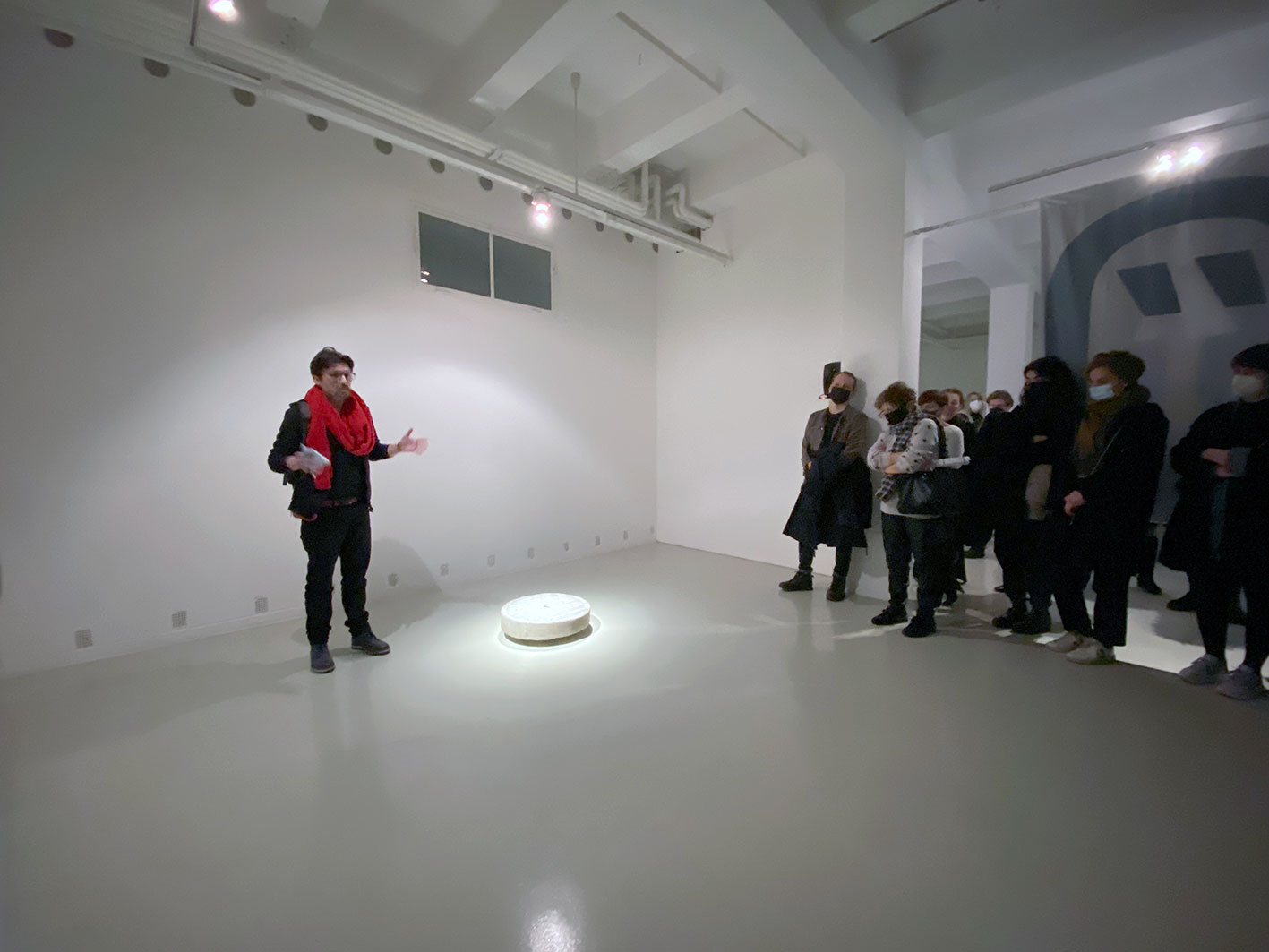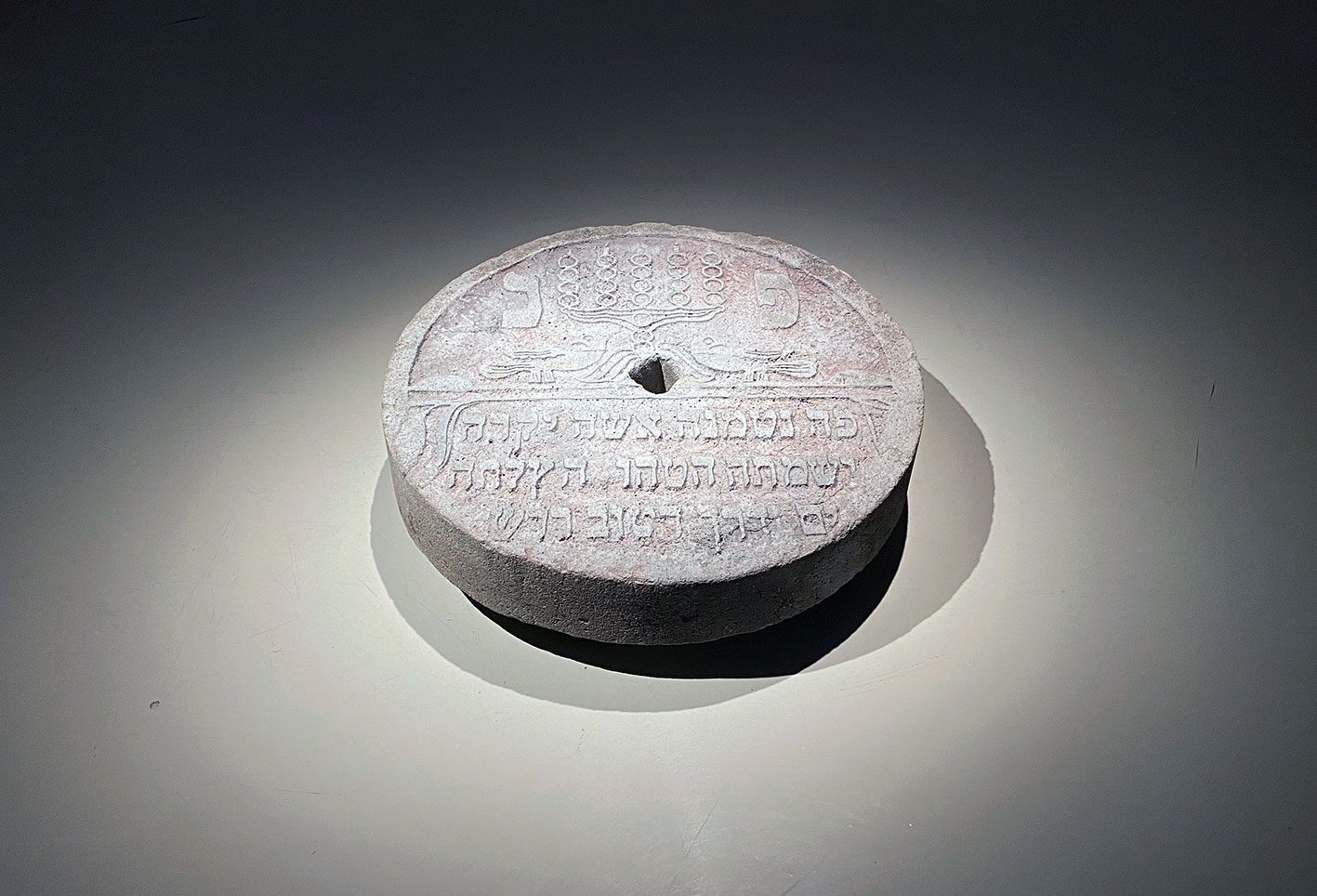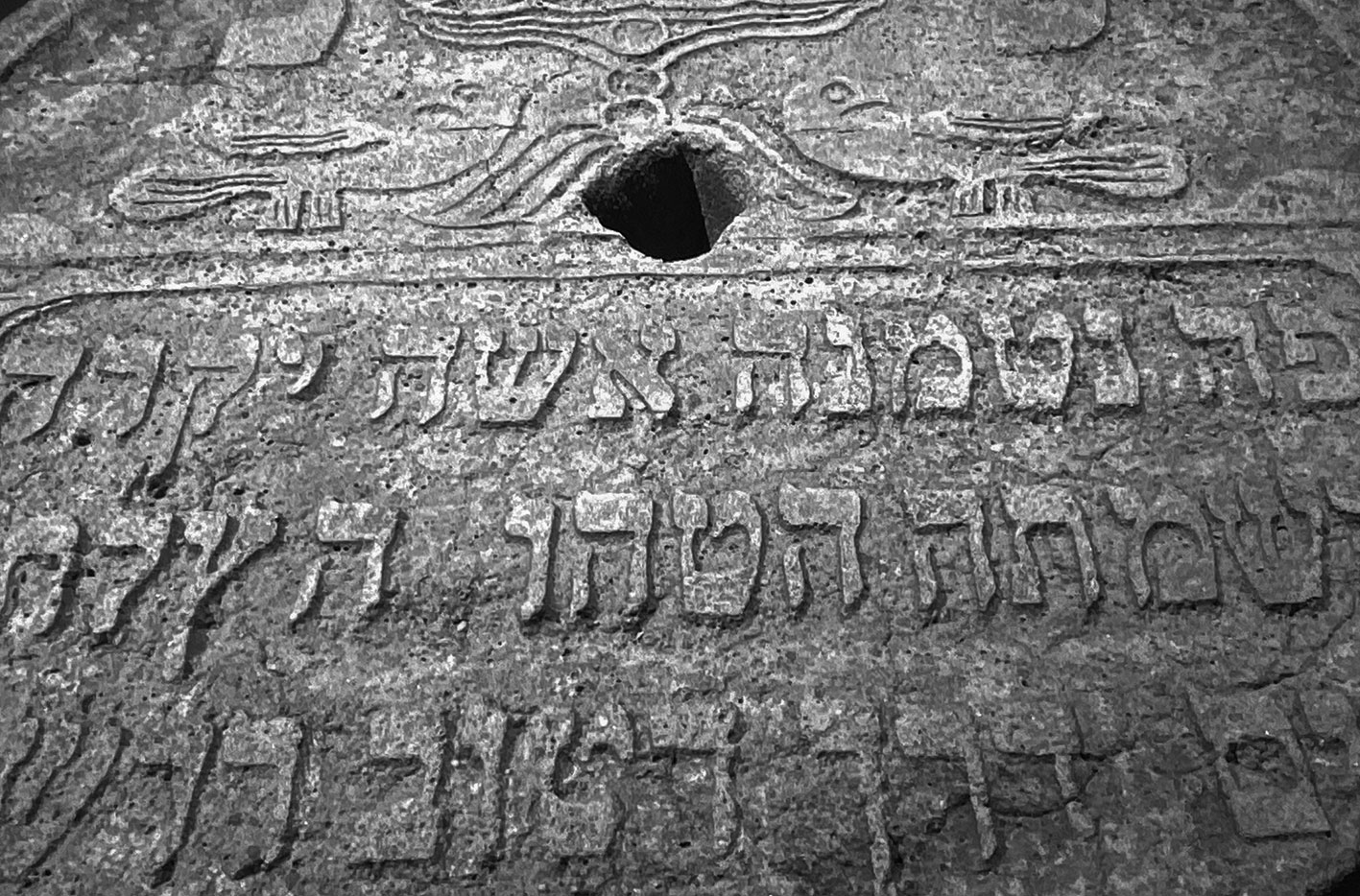Miféle reneszánsz? / What kind of renaissance?
(for English scroll down and see the PDF-leaflet on the bottom right)
Installáció, kétcsatornás hang, kő /
Installation, two-channel sound, stone,
ø 56 cm
A mű a rendszerváltást követő, korai 90-es évek Magyarországának két olyan történetét hozza párhuzamba, amelyek időben és térben teljes átfedésben, párhuzamosan bontakoztak ki, ugyanakkor egyáltalán nem, vagy csak nagyon kis mértékben keresztezték egymást.
Mindkét történet helyszíne a délkelet-Magyarországi Szarvas, ahol 1990-ben a sátoraljaújhelyi származású Ronald S. Lauder amerikai üzletember, műgyűjtő és politikai aktivista kezdeményezésére zsidó gyerekek nyaraltatása céljából egy, a rendszerváltás utáni években zsidó reneszánsznak is nevezett intézményes fellendülés egyik meghatározó példájának tekinthető nemzetközi tábor létesült.
A másik történet a Nagy-Magyarország – Történelmi Országközép Emlékműhöz kapcsolódik, aminek története bár a tizenkilencedik század végén indult, 1990-ben, a nemzeti radikalizmus szintén ekkor zajló reneszánszakor nyerte el mai jelentőségét.
A két létesítmény légvonalban másfél kilométerre található egymástól.
–
A JDC-Lauder International Jewish Youth Camp változatos korcsoportba tartozó gyerekeket, fiatalokat nyaraltat turnusonként több száz nemzetközi résztvevővel. Fennállásának 30 éve alatt tízezres nagyságrendben nyaraltak itt táborozók, akikben a szervezők elsősorban »a zsidó közösség iránti elkötelezettséget és a zsidó hagyományok továbbadásának fontosságát« igyekeztek erő- síteni speciális, játékos pedagógiai módszerekkel. A tábor célja egy olyan közösség létrehozása, »amely táplálja és erősíti a szórakoztató oktatáson alapuló egyéni és közösségi fejlődést« fiatalok ezreinek nyújtva ezzel saját identitásukat meghatározó élményt.
A Szarvasi Történelmi Országközép földrajzi koordinátáit egy helyi földrajz-történelem szakos tanár, Mihálfi József határozta és jelölte meg az akkor már nem működő szarvasi Kreszán-malom területén található malomkővel az 1880-as években. A malomkövet az 1919-20 között ott állomásozó román csapatok állítólag ismeretlen helyre vitték. A földrajzi pont helyére 1939-ben egy emlékmű, egy kisméretű négyvitorlás 6,5 m magas szélmalom-modell épült Gödrös István községi mérnök tervei alapján, amely a későbbiekben megsemmisült, majd 1990-ben újraépült. Az emlékmű és a hozzá vezető, 2000-ben kialakított Történelmi Emlékút azóta is a többé, vagy kevésbé radikális nemzeti identitás kifejezésének színhelye.
_
“KissPál Szabolcs a kutatásai során rátalált Łukasz Baksik lengyel fotós néhány művére, amelyek héber feliratos malomköveket ábrázoltak. A háború után a közép-kelet-európai térség több településén tendenciává vált, hogy a különböző okok miatt lebontott zsidó temetők értékes sírköveit újrahasznosítják. Ezek a tárgyak tökéletesen magukba foglalják a rendszerváltás idején Szarvason párhuzamosan kibontakozó két történetet.
A kő két oldalán lévő hangszórókból interjúk hangzanak el, amelyek egyfelől a korszakban a Szarvasi Nemzetközi Zsidó Ifjúsági Táborban nyaralókkal (Paszternák András, Schönberger Ádám, Vadász Éva), másfelől pedig az Országközép Emlékművet is magába foglaló Szarvasi Történelmi Emlékút Közalapítvány elnökével, Szenes János helytörténésszel készültek.” (DT)
– – – –
“The work brings together two stories of Hungary in the early 1990s, after the fall of the regime, that unfolded in time and space in parallel and complete overlap while at the same time not intersecting at all, or only to a very small extent.
Both stories take place in the town of Szarvas in southeastern Hungary, where, in 1990, at the initiative of American businessman, art collector, and political activist Ronald S. Lauder (whose family roots lie in the city of Sátoraljaújhely), an international summer camp was established for Jewish children, a camp which could be considered a defining example of the institutional revival that, in the years following the fall of socialism, was referred to as the Jewish Renaissance.
The other story concerns the Greater Hungary – Historical National Center Monument, the history of which, though it began in the late nineteenth century, came to acquire its present significance in 1990, when a sort of renaissance of national radicalism swept through the country.
The two establishments are 1.5 kilometers apart as the crow flies.
The JDC Lauder International Youth Camp is a summer camp for children and young people of all ages. It welcomes hundreds of participants from all over the world every year. Over the course of the 30 years since it was founded, tens of thousands of young people have attended the camp, where the organizers have sought to foster “a commitment to the Jewish community and a sense of the importance of passing on Jewish traditions.” Using special, playful pedagogical methods, they have striven to create a community “that nurtures and strengthens individual and communal development based on enjoyable education,” offering thousands of young people an experience which will help them shape their sense of identity.
The precise geographical site of the Monument of the Centre of Historical Hungary was determined by a local geography and history teacher named József Mihálfi in the 1880s. Mihálfi used a millstone to mark the site near a then defunct mill in Szarvas. The stone was allegedly moved to an unknown location by Romanian troops who were stationed in the area in 1919–20. A monument—a small model of a windmill 6.5 meters tall with four blades—was built on the site in 1939. It was based on the designs of István Gödrös, a municipal engineer. The model was later destroyed and was then rebuilt in 1990. The monument and the Historical Memorial Trail leading to it, built in 2000, have since been a site for the expression of a more or less radical attachment to national identity.”
– – –
In the course of his research, Szabolcs KissPál came across works by Polish photographer Łukasz Baksik which depicted millstones with Hebrew inscriptions. After the Second World War, in many settlements in Central and Eastern Europe, people often reused valuable gravestones from Jewish cemeteries that had been demolished for various reasons. These objects eloquently capture the two stories that unfolded in parallel in the city of Szarvas during the period of the regime change in Hungary. Interviews are played from speakers placed on both side of the stones, interviews which were done, in one case, with people who attended the International Jewish Youth Camp in Szarvas during the period (András Paszternák, Ádám Schönberger, Éva Vadász) and, in the other case, with a local historian (János Szenes), who is also the president of the Szarvas Historical Memorial Route Foundation, which includes the National Center Monument.
Közreműködők/Collaborators:
Paszternák András,
Schönberger Ádám,
Szenes János,
Vadász Éva
Köszönet/Thanks:
Ábrahám Vera,
Balogh István,
Łukasz Baksik,
Bányai Viktória,
Félix Anikó,
Lipták Mihály,
Mircea Cernov,
Kékesi Zoltán,
Koller Margit,
Natalia Romik,
Toronyi Zsuzsa,
Tóth Tamás
Trafó Gallery, Budapest
2021/12/18 – 2022/01/30






Lassabb hajnalt! Enyészpontok 4.0 / Slower dawn! Vanishing points 4.0 –
Kurátor / Curator: Tamás Don, Trafó Gallery Budapest 2021/12/18 – 2022/01/30 – Photos: Tra Nguyen
The track is in Hungarian. For English translation see the PDF below